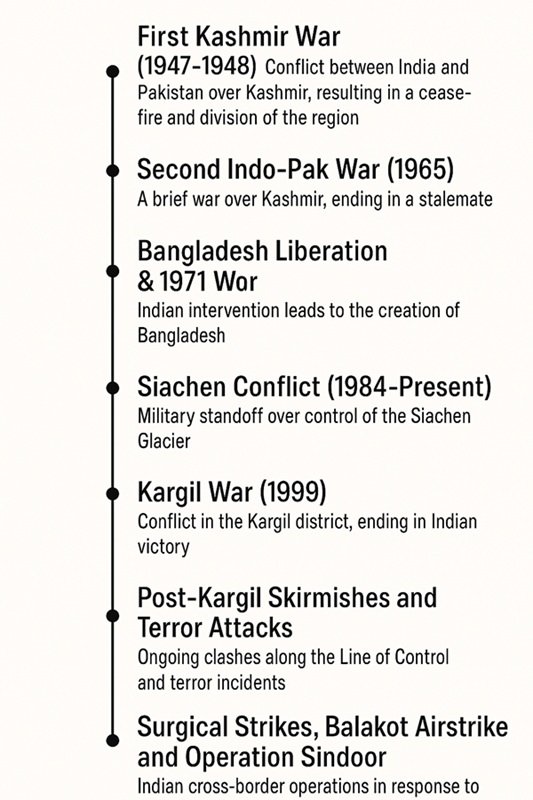
India and Pakistan have shared a tumultuous relationship since their simultaneous independence in 1947. Rooted in the violent legacy of Partition, the Kashmir dispute has been the primary source of multiple wars, border skirmishes, and long-standing hostility. Here is a comprehensive timeline of the Indo-Pak conflicts from 1947 to the Kargil War and beyond.
Table of Contents
- First Kashmir War (1947-1948)
- Second Indo-Pak War (1965)
- Bangladesh Liberation & 1971 War
- Siachen Conflict (1984-Present)
- Kargil War (1999)
- Post-Kargil Skirmishes and Terror Attacks
- Surgical Strikes, Balakot Airstrike and Operation Sindoor
- Conclusion

First Kashmir War (1947–1948)
Background
Soon after independence, the princely state of Jammu and Kashmir became a flashpoint. Maharaja Hari Singh hesitated to accede to either India or Pakistan. On October 22, 1947, tribal militias backed by Pakistan invaded Kashmir.
Key Events
- October 26, 1947: Maharaja Hari Singh signed the Instrument of Accession with India.
- Indian troops were airlifted to Srinagar under Operation Gulmarg.
- Fierce fighting occurred in Baramulla, Uri, and Poonch.
- India took the issue to the United Nations.
Ceasefire
- A UN-mediated ceasefire came into effect on January 1, 1949.
- Line of Control (LoC) was established as a temporary boundary.
Second Indo-Pak War (1965)
Background
Pakistan launched Operation Gibraltar to infiltrate Jammu and Kashmir and incite rebellion.
Timeline
- August 1965: Infiltration begins.
- September 1: Pakistan launches a full-scale offensive in the Chamb sector.
- India retaliates by crossing the international border in Punjab and targeting Lahore and Sialkot.
Ceasefire and Tashkent Agreement
- Ceasefire on September 23, 1965, brokered by the UN.
- Tashkent Agreement signed on January 10, 1966 between Lal Bahadur Shastri and Ayub Khan, mediated by the USSR.
Bangladesh Liberation & 1971 War
Prelude
- Internal turmoil in East Pakistan led to military repression in March 1971.
- India, under Indira Gandhi, supported the Mukti Bahini and provided refuge to 10 million Bangladeshis.
Major Events
- December 3: Pakistan launched preemptive air strikes on Indian airbases (Operation Chengiz Khan).
- India launched a full-scale war on both eastern and western fronts.
- Indian Navy’s Operation Trident targeted Karachi harbour.
Surrender
- December 16, 1971: Pakistan’s Eastern Command, led by Lt. Gen. A. A. K. Niazi, surrendered to Lt. Gen. Jagjit Singh Aurora.
- Creation of Bangladesh as a sovereign nation.
- Over 90,000 Pakistani soldiers became POWs.
Simla Agreement
- Signed in July 1972, converting the ceasefire line into the Line of Control (LoC) and promoting bilateral resolution of disputes.
Siachen Conflict (1984–Present)
Strategic Importance
Siachen Glacier, at the junction of the LoC and the Chinese border, became a flashpoint due to its strategic altitude.
Operation Meghdoot
- Launched by India in April 1984 to preempt Pakistani occupation.
- India gained control of major passes and posts on the glacier.
Ongoing Standoff
- No official war but continuous deployment and skirmishes in harsh terrain.
- World’s highest battleground with extreme weather-related casualties.
Kargil War (1999)
Background
Pakistani soldiers and militants infiltrated Indian positions in the Kargil sector in early 1999.
Timeline
- May 1999: Infiltration discovered by Indian patrols.
- Operation Vijay launched by Indian Army.
- Air power used under Operation Safed Sagar.
International Pressure
- Pakistan denied official involvement initially.
- Under U.S. and international pressure, Pakistan withdrew by July.
Victory and Legacy
- Indian Army recaptured all infiltrated posts.
- Over 500 Indian soldiers and 350+ Pakistani soldiers died.
- Kargil War became a symbol of India’s military resolve.
Post-Kargil Skirmishes and Terror Attacks
Parliament Attack (2001)
- Pakistani-based terror group JeM attacked the Indian Parliament.
- Led to a major military standoff: Operation Parakram.
Mumbai Attacks (2008)
- 10 LeT terrorists killed 166 people in Mumbai.
- India suspended all peace talks.
Ceasefire Violations
- Regular firing and infiltration across the LoC.
- Civilian casualties and soldier deaths continue.
Surgical Strikes and Balakot Airstrike
Surgical Strikes (2016)
- After the Uri attack (18 soldiers martyred), India launched surgical strikes on terror camps across the LoC on September 29, 2016.
Pulwama & Balakot (2019)
- February 14: Pulwama attack killed 40 CRPF jawans.
- February 26: Indian Air Force struck a JeM training camp in Balakot, Pakistan.
- Aerial dogfight followed; Wing Commander Abhinandan Varthaman was captured and later returned.
Operation Sindoor (2025)
The Pahalgam Massacre: The terrorist attack in Pahalgam was more than an act of violence — it was an atrocity deliberately designed to inflict deep psychological and communal wounds. Armed terrorists stormed a group of Indian tourists, demanded to know their religion, and executed 26 unarmed civilians, including decorated personnel like Indian Navy officer Lieutenant Vinay Narwal, in front of their wives and children.
May 7, 2025 — In a strong retaliatory action following the barbaric terror attack in Pahalgam, the Indian Armed Forces have launched ‘Operation Sindoor’, executing precision strikes on nine terrorist camps located in Pakistan and Pakistan-occupied Jammu and Kashmir (PoJK).
Explore:
- Why India Named Its Pahalgam Counterstrike ‘Operation Sindoor’
- India Launches ‘Operation Sindoor’; Precision Strikes Hit Nine Terror Camps in Pakistan and PoJK
Conclusion
From the 1947 Kashmir invasion to the Kargil conflict and modern surgical strikes, the Indo-Pak rivalry is deeply rooted in geopolitical, religious, and territorial disputes—especially over Jammu and Kashmir. While diplomatic overtures have occurred, peace remains elusive due to persistent cross-border terrorism, military provocations, and trust deficits. Understanding this timeline is key to comprehending South Asia’s enduring instability and the importance of strategic dialogue.






